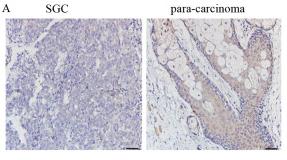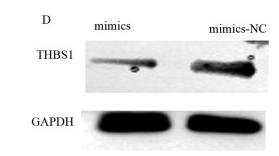THBS1 Antibody - #DF6848
製品説明
*The optimal dilutions should be determined by the end user. For optimal experimental results, antibody reuse is not recommended.
*Tips:
WB: For western blot detection of denatured protein samples. IHC: For immunohistochemical detection of paraffin sections (IHC-p) or frozen sections (IHC-f) of tissue samples. IF/ICC: For immunofluorescence detection of cell samples. ELISA(peptide): For ELISA detection of antigenic peptide.
引用形式: Affinity Biosciences Cat# DF6848, RRID:AB_2838807.
折りたたみ/展開
THBS 1; THBS; Thbs1; Thrombospondin 1; Thrombospondin-1; TSP 1; TSP; TSP1; TSP1_HUMAN;
免疫原
A synthesized peptide derived from human THBS1, corresponding to a region within the internal amino acids.
- P07996 TSP1_HUMAN:
- Protein BLAST With
- NCBI/
- ExPASy/
- Uniprot
MGLAWGLGVLFLMHVCGTNRIPESGGDNSVFDIFELTGAARKGSGRRLVKGPDPSSPAFRIEDANLIPPVPDDKFQDLVDAVRAEKGFLLLASLRQMKKTRGTLLALERKDHSGQVFSVVSNGKAGTLDLSLTVQGKQHVVSVEEALLATGQWKSITLFVQEDRAQLYIDCEKMENAELDVPIQSVFTRDLASIARLRIAKGGVNDNFQGVLQNVRFVFGTTPEDILRNKGCSSSTSVLLTLDNNVVNGSSPAIRTNYIGHKTKDLQAICGISCDELSSMVLELRGLRTIVTTLQDSIRKVTEENKELANELRRPPLCYHNGVQYRNNEEWTVDSCTECHCQNSVTICKKVSCPIMPCSNATVPDGECCPRCWPSDSADDGWSPWSEWTSCSTSCGNGIQQRGRSCDSLNNRCEGSSVQTRTCHIQECDKRFKQDGGWSHWSPWSSCSVTCGDGVITRIRLCNSPSPQMNGKPCEGEARETKACKKDACPINGGWGPWSPWDICSVTCGGGVQKRSRLCNNPTPQFGGKDCVGDVTENQICNKQDCPIDGCLSNPCFAGVKCTSYPDGSWKCGACPPGYSGNGIQCTDVDECKEVPDACFNHNGEHRCENTDPGYNCLPCPPRFTGSQPFGQGVEHATANKQVCKPRNPCTDGTHDCNKNAKCNYLGHYSDPMYRCECKPGYAGNGIICGEDTDLDGWPNENLVCVANATYHCKKDNCPNLPNSGQEDYDKDGIGDACDDDDDNDKIPDDRDNCPFHYNPAQYDYDRDDVGDRCDNCPYNHNPDQADTDNNGEGDACAADIDGDGILNERDNCQYVYNVDQRDTDMDGVGDQCDNCPLEHNPDQLDSDSDRIGDTCDNNQDIDEDGHQNNLDNCPYVPNANQADHDKDGKGDACDHDDDNDGIPDDKDNCRLVPNPDQKDSDGDGRGDACKDDFDHDSVPDIDDICPENVDISETDFRRFQMIPLDPKGTSQNDPNWVVRHQGKELVQTVNCDPGLAVGYDEFNAVDFSGTFFINTERDDDYAGFVFGYQSSSRFYVVMWKQVTQSYWDTNPTRAQGYSGLSVKVVNSTTGPGEHLRNALWHTGNTPGQVRTLWHDPRHIGWKDFTAYRWRLSHRPKTGFIRVVMYEGKKIMADSGPIYDKTYAGGRLGLFVFSQEMVFFSDLKYECRDP
種類予測
Score>80(red) has high confidence and is suggested to be used for WB detection. *The prediction model is mainly based on the alignment of immunogen sequences, the results are for reference only, not as the basis of quality assurance.
High(score>80) Medium(80>score>50) Low(score<50) No confidence
研究背景
Adhesive glycoprotein that mediates cell-to-cell and cell-to-matrix interactions. Binds heparin. May play a role in dentinogenesis and/or maintenance of dentin and dental pulp (By similarity). Ligand for CD36 mediating antiangiogenic properties. Plays a role in ER stress response, via its interaction with the activating transcription factor 6 alpha (ATF6) which produces adaptive ER stress response factors (By similarity).
Secreted. Cell surface. Secreted>Extracellular space>Extracellular matrix. Endoplasmic reticulum. Sarcoplasmic reticulum.
Note: Secreted by thrombin-activated platelets and binds to the cell surface in the presence of extracellular Ca(2+) (PubMed:6777381). Incorporated into the extracellular matrix of fibroblasts (PubMed:6341993). Also detected in the endoplasmic reticulum and sarcoplasmic reticulum where it plays a role in the ER stress response (By similarity).
Belongs to the thrombospondin family.
研究領域
· Cellular Processes > Cell growth and death > p53 signaling pathway. (View pathway)
· Cellular Processes > Transport and catabolism > Phagosome. (View pathway)
· Cellular Processes > Cellular community - eukaryotes > Focal adhesion. (View pathway)
· Environmental Information Processing > Signal transduction > Rap1 signaling pathway. (View pathway)
· Environmental Information Processing > Signal transduction > PI3K-Akt signaling pathway. (View pathway)
· Environmental Information Processing > Signal transduction > TGF-beta signaling pathway. (View pathway)
· Environmental Information Processing > Signaling molecules and interaction > ECM-receptor interaction. (View pathway)
· Human Diseases > Infectious diseases: Parasitic > Malaria.
· Human Diseases > Infectious diseases: Viral > Human papillomavirus infection.
· Human Diseases > Cancers: Overview > Proteoglycans in cancer.
· Human Diseases > Cancers: Overview > MicroRNAs in cancer.
· Human Diseases > Cancers: Specific types > Bladder cancer. (View pathway)
参考文献
Application: IHC Species: Human Sample: SGC tissues
Application: WB Species: Human Sample: SGC cells
Application: IF/ICC Species: Human Sample: SGC cells
Restrictive clause
Affinity Biosciences tests all products strictly. Citations are provided as a resource for additional applications that have not been validated by Affinity Biosciences. Please choose the appropriate format for each application and consult Materials and Methods sections for additional details about the use of any product in these publications.
For Research Use Only.
Not for use in diagnostic or therapeutic procedures. Not for resale. Not for distribution without written consent. Affinity Biosciences will not be held responsible for patent infringement or other violations that may occur with the use of our products. Affinity Biosciences, Affinity Biosciences Logo and all other trademarks are the property of Affinity Biosciences LTD.



